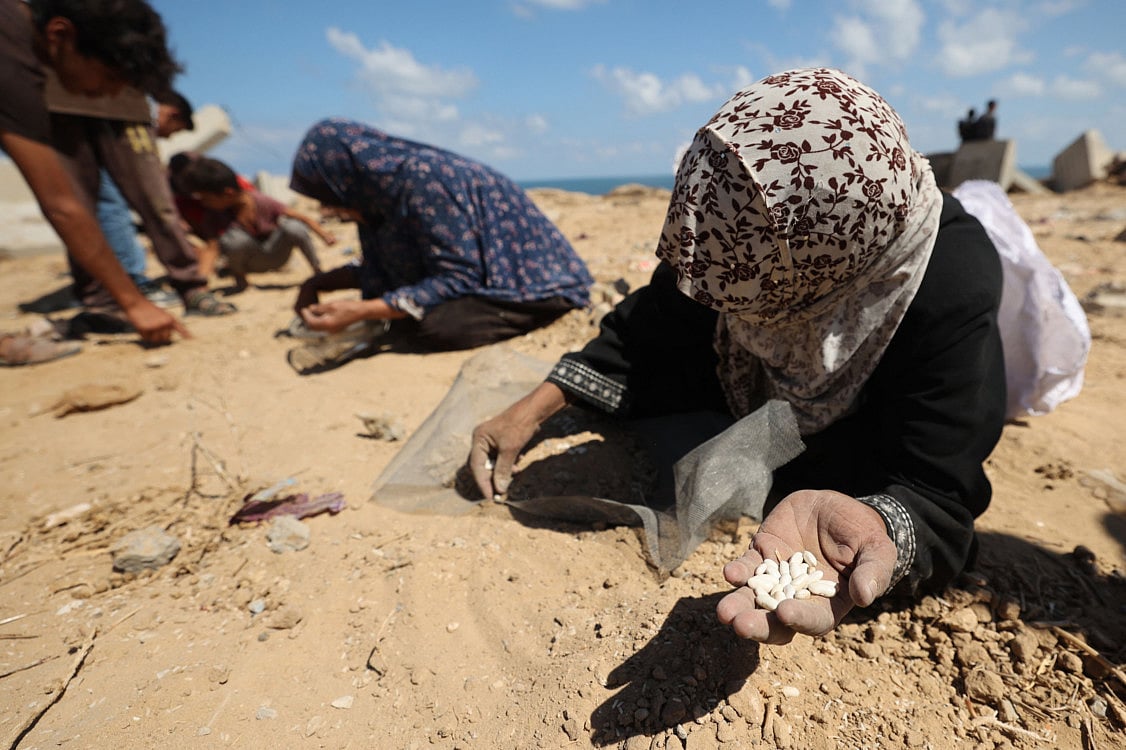Amid ruins and loss, Gazans endure as war’s pain enters a third year
Two years into destructive military campaign, Israel faces genocide charges and isolation

Dubai: Two years after Hamas’ October 7, 2023, attack plunged Gaza and the wider Middle East into war, the militant group is battered but not broken, Israel is militarily dominant yet politically adrift, and Washington remains its indispensable backer with no clear path to peace.
The attack — the deadliest on Israeli soil — killed about 1,200 people and triggered one of the most destructive military campaigns since World War II.
Tens of thousands of Palestinians have been killed, much of Gaza flattened, and famine has taken hold in parts of the blockaded enclave.
The conflict soon metastasized into a regional war, drawing in Lebanon’s Hezbollah, armed groups in Syria, Iraq and Yemen, and their patron, Iran — which suffered major losses during a 12-day Israeli offensive earlier this year.
Through it all, Hamas has clung to influence in what remains of Gaza, still holding 48 hostages, around 20 of whom Israel believes are alive.
Wars without Washington
According to the Costs of War Project at Brown University, Israel’s military campaigns across Gaza and the wider region would not have been sustainable without more than $21 billion in US assistance since 2023. Analysts agree that Washington’s weapons, financing, and diplomatic cover have been crucial to Israel’s operations.
“US support for Israel at all levels is indispensable to the prosecution of Israel’s war both in Gaza and across the region,” Omar H. Rahman, a fellow at the Middle East Council on Global Affairs, Al Jazeera.
Israel’s war on Gaza alone has killed over 67,000 people and wounded nearly 170,000, while its airstrikes on Yemen and Iran have left hundreds more dead.
A regional hegemon, but globally isolated
Israel’s military has crushed its regional enemies, carried out sophisticated assassinations, and shown unmatched intelligence capabilities — from exploding pagers targeting Hezbollah to long-range strikes on Iranian generals and nuclear scientists.
Yet its tactical successes have deepened its diplomatic isolation. Accused of genocide by rights groups and governments, Israel now faces ICC arrest warrants for Prime Minister Benjamin Netanyahu and his former defense minister. Efforts to normalise ties with Saudi Arabia have stalled, and mass protests at home over the hostages and Netanyahu’s corruption scandals have further divided Israeli society.
Palestinian statehood more recognised
Hamas’ stated goal of returning the Palestinian cause to global attention succeeded — but at an unbearable cost. Western nations have joined the majority of UN members in recognising a Palestinian state, and the ICJ has ruled Israel’s occupation of East Jerusalem, the West Bank, and Gaza illegal.
On the ground, however, Israel has consolidated control from the Jordan River to the Mediterranean, expanded settlements, and displaced tens of thousands across the West Bank. In Gaza, 90 per cent of residents have been uprooted, most cities lie in ruins, and famine persists. Even if the war stops tomorrow, Gaza’s recovery could take generations.
Under Israeli control, Gaza’s landscape has been transformed beyond recognition.
102,067 buildings destroyed
Forces have flattened or bulldozed entire neighborhoods of Gaza City and small farming towns near the border, carved new roads across the enclave, and established fresh military outposts.
According to the UN Satellite Centre, bombardment has covered the Gaza Strip in a blanket of rubble roughly 12 times the size of the Great Pyramid of Giza. Using imagery captured from space, the UN estimates that at least 102,067 buildings have been destroyed — among them schools, universities, medical clinics, mosques, greenhouses, and family homes.
The humanitarian toll is staggering. Charity kitchens are overwhelmed as hundreds of Palestinians jostle for a bowl of lentils. Babies are so malnourished they weigh less than at birth. The Integrated Food Security Phase Classification (IPC) — the world’s leading authority on food crises — said in August that Gaza City had fallen into famine, warning that about 30 percent of people go days without eating. Israel disputes that determination, insisting it facilitates humanitarian aid through inspected corridors.
Hamas and Netanyahu endure
Despite mutual fury — Palestinians at Hamas for provoking devastation, Israelis at Netanyahu for failing to rescue the hostages — both leaders have endured. Hamas still wields a diminished but dangerous guerrilla force, and Netanyahu, Israel’s longest-serving prime minister, has held power by appeasing his far-right allies. He faces elections next year and could lose — unless his ally Donald Trump delivers a ceasefire and hostage release.
Washington’s dilemma
Under both Biden and Trump, US policy has combined rhetoric for peace with unconditional military aid. The latest Trump-backed peace plan calls on Hamas to release hostages and disarm in exchange for Israeli withdrawals, prisoner releases, and massive reconstruction aid. Gaza would come under international administration — without guarantees of reunification with the West Bank.
Hamas has signaled conditional acceptance but seeks revisions. If talks stall, Israel could again escalate. Even if a ceasefire holds, Gaza’s rebuilding and the deeper Israeli-Palestinian conflict will likely remain unresolved — a reminder that two years on, the region is trapped between military dominance and moral exhaustion, with no clear way out.
-- With AP inputs
Sign up for the Daily Briefing
Get the latest news and updates straight to your inbox
Network Links
GN StoreDownload our app
© Al Nisr Publishing LLC 2025. All rights reserved.
